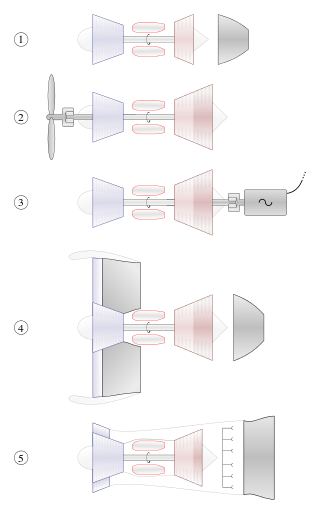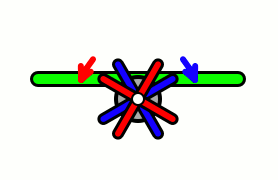Related Research Articles

A PT boat was a motor torpedo boat used by the United States Navy in World War II. It was small, fast, and inexpensive to build, valued for its maneuverability and speed but hampered at the beginning of the war by ineffective torpedoes, limited armament, and comparatively fragile construction that limited some of the variants to coastal waters. In the US Navy they were organized in Motor Torpedo Boat Squadrons (MTBRONs).

A gas turbine, gas turbine engine, or also known by its old name internal combustion turbine, is a type of continuous flow internal combustion engine. The main parts common to all gas turbine engines form the power-producing part and are, in the direction of flow:

The Bristol Proteus was the Bristol Engine Company's first mass-produced gas turbine engine design, a turboprop that delivered just over 4,000 hp (3,000 kW). The Proteus was a reverse-flow gas turbine. Because the second turbine drove no compressor stages, but only the propeller, this engine was classified as a free-turbine. It powered the Bristol Britannia airliner, small naval patrol craft, hovercraft and electrical generating sets. It was also used to power a land-speed record car, the Bluebird-Proteus CN7. After the merger of Bristol with Armstrong Siddeley the engine became the Bristol Siddeley Proteus, and later the Rolls-Royce Proteus. The Proteus was to have been superseded by the Bristol Orion which would have given a Britannia a 75% increase in power for cruising faster.

The Nevada class comprised two dreadnought battleships—Nevada and Oklahoma—built for the United States Navy in the 1910s. They were significant developments in battleship design, being the first in the world to adopt "all or nothing" armor, a major step forward in armor protection because it emphasized protection optimized for long-range engagements before the Battle of Jutland demonstrated the need for such a layout. They also introduced three-gun turrets and oil-fired water-tube boilers to the US fleet. The two Nevadas were the progenitors of the standard-type battleship, a group that included the next four classes of broadly similar battleships that were intended to be tactically homogeneous.

Aircraft equipped with contra-rotating propellers (CRP) coaxial contra-rotating propellers, or high-speed propellers, apply the maximum power of usually a single piston engine or turboprop engine to drive a pair of coaxial propellers in contra-rotation. Two propellers are arranged one behind the other, and power is transferred from the engine via a planetary gear or spur gear transmission. Contra-rotating propellers are also known as counter-rotating propellers, although the term counter-rotating propellers is much more widely used when referring to airscrews on separate non-coaxial shafts turning in opposite directions.

The Bagley class of eight destroyers was built for the United States Navy. They were part of a series of USN destroyers limited to 1,500 tons standard displacement by the London Naval Treaty and built in the 1930s. All eight ships were ordered and laid down in 1935 and subsequently completed in 1937. Their layout was based on the concurrently-built Gridley class destroyer design and was similar to the Benham class as well; all three classes were notable for including sixteen 21 inch torpedo tubes, the heaviest torpedo armament ever on US destroyers. They retained the fuel-efficient power plants of the Mahan-class destroyers, and thus had a slightly lower speed than the Gridleys. However, they had the extended range of the Mahans, 1,400 nautical miles (2,600 km) farther than the Gridleys. The Bagley class destroyers were readily distinguished visually by the prominent external trunking of the boiler uptakes around their single stack.

The Howell Automobile Torpedo was the first self-propelled torpedo produced in quantity by the United States Navy, which referred to it as the Howell Mark I torpedo. It was conceived by Lieutenant Commander John A. Howell, United States Navy, in 1870, using a 60 kg (130 lb) flywheel spun at a very high speed to store energy and drive propellers.

In aeronautics, an aircraft propeller, also called an airscrew, converts rotary motion from an engine or other power source into a swirling slipstream which pushes the propeller forwards or backwards. It comprises a rotating power-driven hub, to which are attached several radial airfoil-section blades such that the whole assembly rotates about a longitudinal axis. The blade pitch may be fixed, manually variable to a few set positions, or of the automatically variable "constant-speed" type.
Frank McDowell Leavitt (1856–1928) was an American engineer and inventor. Leavitt devised one of the earliest machines for manufacturing tin cans and later invented the Bliss-Leavitt torpedo, the chief torpedo used by United States Navy in World War I. Leavitt was part of an emerging cadre of American engineers whose design feats were putting United States manufacturing might on the map at the dawn of the twentieth century.
Asymmetrical aircraft have left- and right-hand sides which are not exact mirror images of each other. Although most aircraft are symmetrical, there is no fundamental reason why they must be, and design goals can sometimes be best achieved with an asymmetrical aircraft.

The Bliss–Leavitt Mark 8 torpedo was the United States Navy's first 21-inch by 21 feet torpedo. Although introduced prior to World War I, most of its combat use was by PT boats in World War II. The torpedo was originally designed in 1911 by Frank McDowell Leavitt of the E. W. Bliss Company and entered full mass production in 1913 at the Naval Torpedo Station in Newport, Rhode Island. It was deployed on destroyers and battleships during World War I and cruisers built in the 1920s. All US battleships and most cruisers had their torpedo tubes removed by 1941. The Mark 8 remained in service through World War II on older destroyers, primarily the Wickes and Clemson classes. It also equipped PT boats early in World War II, but was replaced by the Mark 13 torpedo on most of these in mid-1943.

The Bliss-Leavitt torpedo was a torpedo designed by Frank McDowell Leavitt and manufactured by the E. W. Bliss Company of Brooklyn, New York. It was put into service by the United States Navy in 1904 and variants of the design would remain in its inventory until the end of World War II.
The Whitehead Mark 1 torpedo was the first Whitehead torpedo adopted by the United States Navy for use in an anti-surface ship role after the E. W. Bliss Company of Brooklyn, New York secured manufacturing rights in 1892. The US Navy made an initial acquisition of 100 Mark 1s, which, by the time they entered American service, were faster, had longer range and carried a larger warhead than Robert Whitehead's earlier models.

The Whitehead Mark 3 torpedo was a Whitehead torpedo adopted by the United States Navy for use in an anti-surface ship role after the E. W. Bliss Company of Brooklyn, New York secured manufacturing rights in 1892.
The Bliss-Leavitt Mark 1 torpedo was a Bliss-Leavitt torpedo adopted by the United States Navy for use in an anti-surface ship role after the E. W. Bliss Company of Brooklyn, New York, which had been building Whitehead torpedoes for the US Navy, began designing and manufacturing their own torpedoes in 1904.
The Bliss-Leavitt Mark 3 torpedo was a Bliss-Leavitt torpedo adopted by the United States Navy in 1906 for use in an anti-surface ship role.
The Bliss-Leavitt Mark 4 torpedo was a Bliss-Leavitt torpedo developed and produced by the E. W. Bliss Company in 1908. It was the first American-built torpedo specifically designed to be launched from a submarine. About 100 Mark 4s were purchased for experimental purposes by the United States Navy, which led to design improvements to the gyro and the reducing valve. It was used on submarines of the C and D classes. The Mark 4, and all other torpedoes designed before the Bliss-Leavitt Mark 7 torpedo, were considered obsolete and withdrawn from service in 1922.
The Bliss-Leavitt Mark 6 torpedo was a Bliss-Leavitt torpedo developed and produced by the E. W. Bliss Company in 1911. It employed a main engine that was a horizontal turbine rather than the vertical turbine used on all other Bliss-Leavitt torpedoes. The Mark 6's depth and gyro controls were also combined into one integrated unit. About 100 units were manufactured by E.W. Bliss. It was used on cruisers, destroyers and submarines of the E, F, G and H classes. The Mark 6 and all other torpedoes designed before Bliss-Leavitt Mark 7 torpedo, were considered obsolete and withdrawn from service in 1922.

The Bliss-Leavitt Mark 7 torpedo was a Bliss-Leavitt torpedo developed and produced by the E. W. Bliss Company and the Naval Torpedo Station in Newport, Rhode Island in 1911.
The Bliss-Leavitt Mark 9 torpedo was a Bliss-Leavitt torpedo developed and produced by the E. W. Bliss Company and the Naval Torpedo Station in Newport, Rhode Island in 1915. The Mark 9 was originally intended to be used on battleships. Before the Mark 9 could be issued, however, use of torpedoes on battleships was discontinued and Mark 9 torpedoes were placed in storage. These torpedoes were modified for deployment on R-class and S-class submarines, and used in early World War II to supplement the initial supply of Mark 14 torpedoes. Torpedo production for the U.S. Navy was terminated by the E.W. Bliss Company about 1920 after completion of the Mark 9 project.
References
- ↑ Newpower, Anthony (2006). Iron Men And Tin Fish: The Race to Build a Better Torpedo During World War II. Greenwood Publishing Group. p. 18. ISBN 0-275-99032-X.